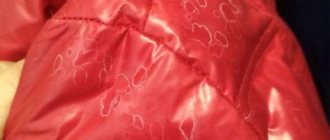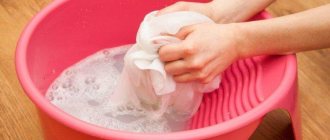Updated: 04/23/2021 12:22:04
Expert: Sofia Borisovna Fridman
Stains may unexpectedly appear on your down jacket: from blood, grease, ink, tea or fruit juice. And prolonged wear leads to the fact that pockets and sleeves become glossy and shiny. Warm winter clothes are not cheap, so they need to be saved, and various stains are not a reason to throw away your favorite down jacket. But not every method of getting rid of dirt from clothes is suitable - you need to take into account the material from which the product is made and the features of caring for the filling - natural or artificial down. Our experts learned how to remove various stains from a down jacket without leaving any traces or any consequences for its appearance.
Basic rules of care
Down jackets are not clothes that can be washed frequently. Many products are dry clean only (care instructions are always indicated on the label). From frequent washing, down will lose its warming qualities, and the top layer of fabric will lose its appearance and wear resistance. The down jacket will allow moisture to pass through and will no longer protect against frost and wind.
Therefore, small stains that appear should be washed off locally. And contaminants such as blood, tea, grease or ink cannot be removed by regular washing in an automatic machine without pre-treatment.
So, if a stain appears on your down jacket, you need to:
- carefully study the label - if it is only allowed to be dry cleaned, then we take the jacket to professionals;
- if you can wash it in a machine and use wet cleaning, then select a detergent to remove stains in accordance with their origin, material and color of the top of the product (taking into account the recommendations that will be given below);
- Please note that it is not recommended to use chlorine bleaches to get rid of stains, but most oxygen stain removers for colored and white items can be used for down jackets;
- stains should be scrubbed with a detergent mixture, moving from the edges to the center - this will help avoid streaks and make it easier to remove the remnants of the product used after treatment;
- evaluate the appearance of the product after local removal of stains and drying - if there are stains or marks on the surface, then the down jacket should still be washed in an automatic machine on a delicate cycle at a temperature of 400C with liquid detergent.
- Laundry soap can remove most stains. Therefore, our experts advise starting stain removal with it - just rub the stained area thoroughly with it and leave for 10-15 minutes. The disadvantage of washing with soap is that it requires a large amount of water to rinse off, so it is more suitable for pre-treatment before washing in the machine.
And one more piece of advice: don’t put off stain removal “on the back burner” - the fresher the stain, the easier it is to wash it off without leaving any traces or tedious washing.
Preparation
Just as the process of cleaning a down jacket is important, the process of preparing for it is also important. It doesn’t matter whether you clean the entire jacket or just part of it, try to follow these tips step by step:
- Provide good lighting. In dim or uneven light, you may not notice that you missed a spot somewhere, or that streaks have formed somewhere.
- Wear rubber gloves.
- Hang the down jacket on a hanger - this will make it convenient to carry out all the following operations.
- Check all the pockets - you need to take out everything that is in them. A small paperclip will leave rusty marks, forgotten candy will ruin the fabric, etc. There are many options - all of them are based on someone’s bitter experience.
- Unfasten everything you can: hood, fur, mittens, belt and other removable parts.
- Button up all pockets and shirtfronts.
- Read the recommendations on the product label.
- Before removing local contamination with a stain remover, try treating the stain with regular wet wipes. In 50% of cases it actually works. Well, if not, at least it will make the stain remover’s job easier.
How to remove grease stains
Grease stains often appear on a down jacket, but removing them is not difficult. Especially if they are fresh. You can choose from one of five methods. Each of them is safe for the material from which the down jacket is made and for down.
Dishwashing liquid (Fairy, Sorti)
Mode of application:
- wet the area stained with grease with water;
- drop a few drops of the product (depending on the size);
- wait 5-10 minutes;
- Use a clean cloth soaked in water to carefully remove foam and Fairy residue.
If necessary, machine wash.
Mustard
Mustard contains allylic oil, which breaks down fats well. It is suitable for removing stains from colored down jackets.
How to use:
- add warm water to dry mustard powder to obtain a mass similar in consistency to thick sour cream;
- apply the mixture to the stain;
- leave for 30 minutes;
- Wash off the mustard with a cloth soaked in warm water.
An easy-to-use, but quite effective way to remove fresh grease stains is to place mustard plaster soaked in warm water on the stained area for 20-30 minutes. Simply remove the remaining mustard, and the fat will also dissolve without a trace.
Soda or salt
You can sprinkle a small amount of salt or soda on a fresh greasy stain left on a down jacket. Or you can make a paste-like mass by mixing them with warm water and apply to the stain for 15 minutes. Rub the stain with a toothbrush, after which the remaining soda or salt (or a mixture of them) should be removed with a cotton napkin soaked in water.
Grated laundry soap
In order not to wash off the foam from laundry soap, you can use a simpler method: grate it (2 tsp) and apply it to the stain. The shavings will absorb the fat, all that remains is to brush them off the surface of the down jacket. This method is only suitable for fresh stains.
Talc or chalk
Talcum powder or crushed chalk sprinkled on a greasy stain on a down jacket also works well to remove grease. On old stains, you can apply a mixture of talc and chalk and let it sit for 2-3 hours. Wipe off any remaining residue with a napkin or clean wet cloth.
Cleaning Rules
As you can see, the procedure is serious, since it requires such thorough preparation. Let's move on to the basic cleaning rules:
- Try to remove minor stains as quickly as possible (remember the wet wipes). Later it is much more difficult to remove them.
- If you are going to clean your jacket with a special cleaner, test it on the inside, in an inconspicuous place.
- If you clean the entire down jacket by hand, start with the most contaminated areas: cuffs, collar, hem, pockets.
- Remember that a jacket with natural fillings should never be soaked.
- If you use water to remove stains, keep the temperature at 40 degrees. Otherwise, the fabric may fade.
- At the end of the season, the down jacket always needs to be completely cleaned. The item is put into the closet only in its clean form.
- Do not dry your down jacket near heating devices or in the sun. It is better to dry it in the fresh air in natural conditions, in the shade, by laying the jacket on a horizontal surface. This way, the filler will be distributed more evenly and dry well. At the same time, from time to time it needs to be moved in each of the quilted compartments so that it does not cake.
How to get rid of blood stains
Unfortunately, bloody stains can also appear on your down jacket and should also be removed while they are fresh.
The main rule for removing blood from any fabric is not to wash it with hot water. At temperatures above 400C, blood protein coagulates, leaving a yellow mark on the product after washing, which is not easy to get rid of later.
The most effective means for removing blood drops from clothes is hydrogen peroxide 3%. But it can only be used on light-colored materials; on colored and dark materials, a discolored mark may remain.
Mode of application:
- apply a few drops of peroxide to the contaminated area;
- wait 10-15 minutes;
- rub with a toothbrush soaked in cold water.
Blood stains after mechanical treatment may still be visible. They are easily removed during subsequent washing in an automatic machine.
To restore cleanliness to colored jackets, you should use a paste of soda and water (2:1 ratio). The mixture is applied to the bloody mark for 10-15 minutes and, using a moistened toothbrush, removes dirt and soda residues.
Tip from our experts: A small spot of fresh blood can be easily removed with saliva. If after bleeding from the nose there are red drops left on the down jacket, you can simply spit on them and rub the saliva over the contaminated surface. The method, although not very hygienic, is effective.
LiveInternetLiveInternet
Quote from Alinochka_Luneva's message
Read in full In your quotation book or community!
How to remove a stain. 20 ways to remove any stain!
First you need to figure out what was planted with and how deep the stain penetrated. Stains can be greasy or non-greasy. Fat stains from milk, butter, blood, soups, meat, fish and so on - the contours are fuzzy, at first darker than the fabric, and then fades. Fruit, wine, beer, tea and coffee stains have clear boundaries, with a lighter stain in the middle. Many stains oxidize when exposed to air. Determine what kind of fabric you have in front of you; usually the composition is indicated on a tag sewn on the inside.
Stain remover arsenal. Alcohol, baking soda, dish soap, ammonia, vinegar, starch, acetone, gasoline, citric acid, glycerin, turpentine (tiner) and hydrogen peroxide. A pipette, brushes of varying softness, pieces of sponge and clean cotton rags (can be cut from unwanted clothes). All this can be purchased at a pharmacy or the nearest hardware store. Dangers of stain removal. · 1. Stain removers, like medicines, have side effects, so you need to try them on an invisible piece. · 2. Industrial stain removers, such as Sano Oxygen, Potassium and others like them, leave permanent stains if left on clothing and allowed to dry. So we sprayed it, waited a couple of minutes, and into the water. · 3. Do not use bleach (economy), not only does it have a harmful effect on health and cause mutations in genes, it also destroys the structure of cotton fabric and leaves a terrible smell. · 4. Any solvent can dissolve paint on clothing. · 5. Acetate silk dissolves in acetone and vinegar. · 6. Bleaching agents are only for whites. · 7. Work the stain from the edges to the middle. Place a clean white rag, laid in several layers, on the inside of the stain. · 8. To avoid streaks, moisten the cloth around the stain with water and wash the entire item immediately afterward. · 9. Water stains remain on silk, so you will have to wet the entire thing. Secret laboratory. Several common areas. The musty smell of stale clothes is removed with vinegar. Just add vinegar when washing; if the smell is too strong, soak the item in water with vinegar. Many stains can be removed with regular dish soap. Stains: 1. from animal fat (fat, butter, margarine): · a. Before washing, it is recommended to iron fresh stains with a slightly heated iron through 2-3 layers of blotting paper, also placing it under the stain. After this, the stain is cleaned with gasoline or stain remover. · b. Dilute ammonia in hot water (1:1). Treat the stain. Wash. · V. Soak the stain with a mixture of pure alcohol (half a glass) and gasoline (half a teaspoon). Allow the fabric to dry. · d. If the item cannot be washed, then heat the starch strongly and sprinkle it on the contaminated area, under which place a white cloth. Leave for 20 minutes and shake off. Repeat until the stain disappears. Then clean everything with a brush. · e. For light woolen fabric, you need to dilute the potato flour with water to a paste and leave for several hours. Rinse and dry. If traces remain, they are removed with a cloth soaked in gasoline, and then wiped with pieces of stale bread. 2. from grass · a. Mix 1 liter of water and 1 tablespoon of ammonia and blot the stain with this solution. wash. · b. Moisten the stain with alcohol, and then wash the item. · V. Fresh stains will come off when washed. 3.from red wine · a. Wash with white wine · b.You can also sprinkle salt on a fresh stain and then wash. · c. Treat old stains with a solution of citric acid (2 grams per 1 glass of water) and rinse with warm water. If after this there are traces left on the white fabric, they can be wiped with a mixture of hydrogen peroxide and ammonia (1 teaspoon per glass of hot water). Rinse with cold water 4.from white wine · a. Rub a piece of ice over the stain until it disappears. Blot this area with a clean linen cloth or napkin (if there is no ice, you can use very cold water). beer usually comes off when washed · b. On silk fabrics - treat with a swab soaked in vodka. · V. On all types of fabrics, treat with a mixture of glycerin, ammonia and wine alcohol and water (1: 1: 1: 8). The same method is suitable for removing champagne stains. 5.blood · Rinse in cold water and then wash at a temperature of 30-40? C 6.from ice cream · Blot the stain with a swab dipped in gasoline and then wash. from fruits, vegetables, juices and berries · a. Soak a swab in vinegar (not wine vinegar) and blot the stain with it. Rinse in cold water. · b. Cover a fresh stain with table salt (salt absorbs some of the moisture and prevents the stain from spreading). · V. A stain on a white or other non-fading fabric can be doused with boiling water · d. Stains from coffee and black tea will come off with washing. 7.from chocolate · a. Sprinkle a fresh stain with salt and moisten with water. Wash. · b. Treat with a warm 1.5 percent solution of ammonia. · V. From light-dyed wool and silk fabrics, stains are moistened with slightly warmed glycerin. After 15 minutes, rinse with warm water. · d. Treat with a solution of vinegar and alcohol (1:1). 8.from chewing gum · Put the item in a bag and place it in the freezer of the refrigerator. After an hour, you can remove the remains with a dull knife (very carefully so that you don’t have to do artistic darning later). Place on a paper towel and wipe from the inside with cotton wool soaked in gasoline, alcohol or acetone. And now - off to the wash. 9.from eggs · a. Cover the fresh stain with salt and add a few drops of water. After half an hour, remove everything with a brush. · b. Stains on colored fabrics are smeared with heated glycerin. After 20 minutes, wipe with a swab soaked in glycerin and rinse with water. · V. On white fabrics, stains are moistened with a solution of ammonia (1:10), then wiped with the same solution. And in the wash. 10.from ink · a. Soak a cotton swab in alcohol and lightly tap the stain, and then wash the item. You can take a mixture (1:1) of wine alcohol and ammonia. · b. Rub fresh ink stain with lemon juice or citric acid. Wash. 11. from resin · a. From woolen fabrics - with purified turpentine. · b. From cotton fabrics - turpentine or gasoline. Wash. · V. Items that cannot be washed are best taken to the dry cleaner. 12.from lipstick · Place the stain on a paper towel and wipe from the inside with a cotton swab dipped in alcohol or gasoline, changing the paper often. Soak and wash. 13.from nail polish · Place the fabric stain on a paper towel. Wipe the inside out with nail polish remover several times until the stain disappears. Wash. 14.from the ground · Soak the item in water and vinegar 1:1. Wash. 15. Tobacco most often comes off when washed. · A. If the item cannot be washed, then remove the stain with warm glycerin or denatured alcohol. · b. The safest and easiest thing is to take the item to the dry cleaner. 16.from candles (the main component is wax or paraffin) · a. Using a blunt knife, carefully remove any remaining wax (as you would with chewing gum). Iron the fabric between layers of paper towel. In this case, place the fabric wrong side up. And now - off to the wash. 17.from rust · Place a piece of lemon wrapped in gauze and a paper napkin on the contaminated area. Press it with a heated iron. 18.from milk · Soak in glycerin “for a long time.” 19. from urine · a. Treat with wine alcohol. · b. On white fabrics, you can treat with a solution of citric acid (1:10). · V. On colored fabrics - with a solution of vinegar (1:5). After an hour, rinse the stain with water. 20.from mold · a. Wash cotton and linen fabrics in boiling mode. · b. Treat with ammonia diluted in water 1:5. · c. Soak in bleach (hydrogen peroxide, “sano oxide”, not bleach, under any circumstances). · d. Treat white fabric with a mixture of hydrogen peroxide and ammonia. · e. Dyed wool and silk fabrics are treated with turpentine. Wash in warm water. Sweat usually disappears when washed. · A. You can wipe with a solution of table salt (1 tablespoon per 1 glass of water). · b. Dyed wool fabrics are carefully treated with gasoline or acetone.
How to remove an ink stain
If an ink stain appears on your down jacket (a ballpoint pen has leaked in your pocket or a pen mark has accidentally left behind), then one of the following methods will help remove it.
- Ethanol
. Pour a few drops onto the ink mark and use a cotton swab or cotton pad to wipe off the stain.
- Hair fixation spray.
Spray a sufficient amount of varnish from the bottle onto the stain - it will dissolve before your eyes. Without waiting for it to dry, wipe off the mark with a napkin, and if necessary, apply the varnish again. After removing colored stains, the contaminated area should be thoroughly rinsed with clean water.
- Stain remover
. Vanish or any other oxygen bleach, if applied directly to an ink stain, will also remove it without leaving any traces.
- Kefir.
Can be used as an emergency cleanser. The fermented milk drink will not dissolve the ink, but will destroy its structure and will not allow it to be deeply absorbed into the fibers of the fabric before treatment with stronger agents. After exposure to lactic acid, the mark becomes lighter.
The fresher it is, the faster the ink stain will go away. Only dry cleaning can remove old marks from a ballpoint pen.
How can you use Bologna to padding polyester?
Bolognese jackets with padding polyester filling are incredibly popular today. That is why the issue of caring for them is so relevant today. Of course, you can remove grease stains and abrasions by contacting a professional dry cleaner, but in this case you will have to spend a lot of time and money.
It is not recommended to wash a dutik jacket, because it can fade, and it will be more difficult to remove unsightly marks, but there are other methods - peroxide, citric acid, kerosene. To begin with, you can try to deal with stains yourself, turning to folk methods that have been proven over the years for help.
Information. Kerosene is the most effective folk remedy for removing stains from bolognese products with padding polyester.
Method one:
- Mix approximately 500 milliliters of warm water with 50 grams of washing powder. The product should be suitable for fabric of any color;
- Using a soft brush or sponge, transfer the mixture to the dirt and rub it;
- Take a cotton pad, soak it in acetic acid and wipe the stain;
- Use a damp sponge to remove any remaining product from the surface of the product.
This is interesting: How to wipe foam from things without leaving marks
Method two:
- For this method, you will have to purchase a special laundry soap called “Antipyatin”;
- Rub dirty areas thoroughly using this product;
- Do not touch the item for about thirty minutes;
- At the end of the procedure, carefully remove any remaining product with a moistened soft sponge.
Method three:
- Take the most common tooth powder and apply a small amount to the stain;
- Use a soft toothbrush to rub it in;
- Cover the stain with a regular sheet of paper;
- Place a cold iron on top and do not touch the structure for 24 hours;
- At the end of the procedure, carefully remove the tooth powder and wipe the area with a damp sponge.
Important! These simple methods will not only remove dirt, but also maintain the attractive appearance of your favorite jacket or coat.
Rub off with nylon
Nylon fabrics are incredibly delicate, so using the methods presented above to remove dirt from such products is risky.
We present to you the safest and most effective method, which involves the use of laundry soap:
- Grate a piece of laundry soap on a fine grater;
- Wet a nylon cloth with water and lightly rub the stain with a whole bar of soap;
- Sprinkle soap shavings on top;
- Leave the product alone for several hours;
- After time has passed, remove any remaining soap and wipe the stain with a warm alcohol solution.
Attention! To get rid of odors, soak a cloth in water and fabric softener, wipe the item down, and then hang it in a well-ventilated area to dry.
How to remove tea stain
Any acid found in the household can remove tea stains perfectly:
- lemon;
- vinegar;
- dairy.
- You need to moisten the tea trail with warm water and apply a small amount of lemon juice, table vinegar or kefir to it. After waiting 15-20 minutes, rub the stained area with a sponge or toothbrush and rinse with clean water.
- To clean light down jackets, you can use 3% hydrogen peroxide, and a colored or dark down jacket can be cleaned of tea stains with warm glycerin and salt (mix in a 1:1 ratio).
How to clean fur on a down jacket?
Fur parts usually do not need heavy cleaning; they can simply be refreshed.
Natural pile can be carefully cleaned with a sponge soaked in a solution of 9% vinegar (2 tablespoons of acid per 1 liter of water).
It's easier with faux fur. It can be rinsed in soapy water. And then in clean water. After this, it should be hung in a well-ventilated area. After complete drying, comb.
How to remove lipstick or powder stains from your collar
When girls and women wear jackets and down jackets that are fastened at the neck, there are often traces of makeup on the collar. Pink or red spots immediately catch the eye when the zipper is unzipped and do not discolor its owner. It is not difficult to remove them, and this should be done regularly - 2-3 times a week.
Traces of powder are easily washed off when cleaning with a damp, soapy cloth (with toilet or laundry soap). But with lipstick you will have to work hard. You can apply one of the following products to the stained areas:
- hydrogen peroxide 3% (suitable for white or light-colored jackets);
- a mixture of soda and water (in a ratio of 2:1);
- sodium tetraarborate (borax);
- toothpaste;
- laundry soap.
It takes time for the cleaning substances to take effect (about 15-20 minutes) and wipe off any remaining product and lipstick with a toothbrush and a clean napkin.
How to wash shiny areas
Cuffs, areas near pockets and collars of down jackets become greasy and unattractively shiny from prolonged wear. To fix this, you need to sprinkle talc, chalk or starch on the shiny areas for 10-15 minutes, rub them in a little and shake them off. The powders will draw out the fat, and the clothes will again acquire a decent appearance.
This method is not suitable for removing heavy stains. It is better to prepare a cleaning mixture. To do this you need to mix:
- 1 tsp ammonia (ammonia);
- 1 tsp dishwashing detergents;
- 100 g warm water.
Whip up a thick foam and apply it to greasy areas with a sponge. After waiting 5-10 minutes, remove the remaining mixture with a clean napkin.
You can get rid of shine around pockets and on sleeves using window cleaner. Spray it from a spray bottle onto the contaminated area, then clean it with a damp cloth.
What needs to be done before washing?
To prevent the stain from increasing, we make movements from the edge to the center of the contaminated area
To quickly remove stains, you need to take into account the following:
- scrape off the dense layers from the surface of the down jacket as much as possible;
- only clean and white cloth or cotton pads for cleansing;
- wipe the dirt first with a dry cloth, then with a damp one;
- We clean from the edge of the stained area , gradually moving towards the center of the contamination;
- do not use metal brushes or rough materials, they can tear things or leave scratches and pellets;
- We place the sponge on the wrong side of the problem area , it will absorb the stain.
The main rule when removing stains is speed. The sooner you start the cleaning process, the greater the chance that the contamination will completely disappear.
I do not recommend using brushes with hard bristles - there is a risk of damaging the material
Household chemicals
Many stains can be removed from clothing using special household chemicals. Only chlorine-free bleaches and stain removers are suitable for cleaning down jackets:
- Vanish Oxi Action - perfectly removes fresh stains of various origins, average price 130 rubles per 500 ml;
- "Dr. Beckmann" - removes old stains, 200 rubles. for 50 ml;
- Ecover Ecological Stain Remover – an ecological product based on enzymes and citric acid, 700 RUR. for 200 ml;
- ACE Oxi Magic - helps get rid of fresh and old stains, 100 rub. for 500 ml.
All products are sold for both colored and white items, so you can choose a suitable stain remover to remove dirt from down jackets of any color.
How to eliminate white streaks after washing
Often, after washing, white stains remain on down jackets. Sometimes they can appear after snowfall or rain. The reason is insufficient rinsing. This situation occurs especially often after using washing powder. That's why outerwear manufacturers advise using liquid detergents for washing - they rinse out better and don't leave streaks. You can turn on the extra rinse mode.
- If white marks do appear, you can get rid of them using a damp cloth or viscose napkin, rinsing it regularly under running water.
- If the stains are very pronounced, you can first spray them with window cleaning liquid from a spray bottle and then wipe them off with a napkin.
- The most effective method to get rid of white stains is to wash the down jacket in the washing machine again, but without powder or detergent.
Special stain removers
If you are afraid to get involved with folk recipes and various improvised means, then you should pay attention to specialized household chemicals that help clean your down jacket from greasy and stubborn stains at home.
There are many cleaning products on the market, so below are the most effective ones:
- Sano Spark is available in powder form, has a pleasant smell, and a large amount of product;
- Antipyatin soap for removing complex stains, smells nice, is absolutely safe for children and people prone to allergic reactions;
- Vanish is available in several formats, including classic gel, convenient to use, suitable for colored and delicate items;
- Down Wash & Clean is one of the most effective gel products for removing greasy stains; it helps to delicately wash fabrics with a water-repellent coating;
- Ecover stain remover in the form of a spray, acts instantly, removes complex stains;
- Dr. Beckmann gel product, which is available in several variations for different types of products, can only be used according to the instructions;
- Frau Schmidt stain remover in the form of soap, removes grease, oil and wine stains, is safe for the skin, works equally effectively on both white and colored items.
If the manufacturer has not left any special notes on the packaging regarding the use of the product, then the principle of use of the drug will be standard:
- Wet the contaminated area of the product with water.
- Apply the stain remover of your choice using a soft cloth or sponge, rubbing from the edge to the middle of the stain.
- Leave the item for a while so that the product has time to work.
- Rinse the product three times under running water (or remove any remaining product with a damp sponge if you are removing stains locally).
- Dry the down jacket well.











